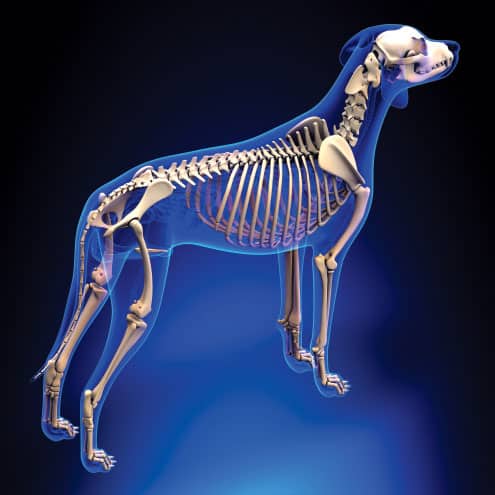STRONG BONES & JOINT STRUCTURE
For dogs and cats a lack of exercise can lead to numerous other health issues, and so the more active we can maintain our pets, the healthier they will be.
If we provide our pet friends to be active by supplying them foods that contain the right nutrients, we can offer a happy, healthy and enjoyable life not only to them but also to ourselves as their parents.
 SKELETON
SKELETON
Throughout life, bone is continuously being created and strengthened, but is also being broken down to liberate the stored calcium and phosphorus for other purposes in the body.
The correct dietary levels of calcium, phosphorus, magnesium and vitamin D are particularly essential to maintain bone formation. Vitamin D stimulates the body to create bone tissue, whilst calcium, phosphorus and magnesium make up the solid bone matrix. It is particularly important to achieve the correct ratio of calcium and phosphorus in the diet, and this ratio should closely match that of bone itself.
LIGAMENTS & TENDONS
Ligaments and tendons are fibrous tissues. They connect the muscles and bones together and provide strength and flexibility to joints. As our pets age they become less flexible and more brittle, which can lead to strains and breakages.
Nutrients such as zinc and omega-6 oils are important to maintain the strength and suppleness of these important tissues.
VITAMINS

Vitamins play an essential role in many functions of the body, including energy production, bone formation, immunity and fluid regulation. All are important for good mobility and motion, and are supplied via the diet. They are also essential for the removal of waste by-products, such as lactic acid, to support endurance and vitality.
The body can store fat soluble vitamins, such as vitamin A and D however, water soluble vitamin like thiamine (B1) and riboflavin (B2) must be provided on a daily basis.
MINERALS
Minerals such as copper and manganese, are required in very small quantities and are important components of enzymes
which are essential for the production of energy. Whilst they are stored in the body in organs such as the liver and kidney,
a regular dietary supply is essential to maintain these reserves.
Other minerals, such as magnesium and calcium, are required in much larger quantities, and are essential for the maintenance of strong bones and fluid regulation. Again, a good dietary supply is also needed.
SKIN
Healthy skin provides support for the skeleton and flexibility for the movement and stretching of the body. As our pets age their skin can become dry, thin and less flexible, which reduces their mobility and increases the risk of damage and inflammation.
Its suppleness and strength rely on good hydration, and a good dietary supply of essential oils and minerals, such as linoleic acid and zinc. Along with other nutrients, these combine to promote the production or collagen, keratin, and sebum, which help to maintain healthy skin into older age.
MUSCLES
Healthy muscles are important for activity, but they also provide strength and support for joints.
Muscles fibres are made up of long chains of amino acids, which are derived from proteins in the food. The quantity and quality of these dietary proteins are extremely important to ensure that the correct combination of amino acids is available for muscle generation. Animal and yeast proteins contain amino acid combinations that most closely match the body’s requirements.
So a diet high in these proteins will ensure that muscle development is optimised.
 JOINTS
JOINTS
Joints consist of bones protected with cartilage layers encapsulated within a fluid-filled chamber. The cartilage and fluid both act to lubricate the joint movement, and protect against abrasion and collision between the ends of the bones. Dehydration can cause the fluid to be reduced, leading to an increased risk of friction between the bones, and poorer lubrication. In both cases, the joint will become stiff and painful. It is therefore essential to maintain good hydration by providing plenty of clean, fresh water, but also to provide sufficient and balanced quantities of minerals and electrolytes in the food, such as sodium, chloride and potassium.
In addition, inflammation outside and within the joint chamber places additional pressure on the joint, which again leads to pain and reduced mobility. Causes include infection, excessive weight and injury, and all can be aided by the inclusion of omega-3 oils in the diet, which act to reduce the inflammatory response. Fish oils, such as anchovy, provide the most effective and concentrated source of these essential oils.
Finally, good cartilage health is essential to maintain flexibility and movement. Healthy cartilage is soft and smooth, and absorbs any impact and friction between bones. As our pets age their cartilage becomes drier, thinner and less flexible, leading to increased friction and abrasion which, in turn, creates inflammation. Joint conditioners, such as glucosamine and chondroitin, promote the production of cartilage, and inhibit its breakdown, thereby helping to maintain supple and flexible joints.
METABOLISM
Energy is generated by metabolism within cellular mitochondria. These metabolic process is managed by enzymes and vitamins, which promote the production of energy from fats and carbohydrates in the diet.

The B-vitamin complex, including thiamine, riboflavin and niacin, are particularly important nutrients to maintain healthy metabolism and, since they cannot be stored in the body, a good, daily dietary supply is essential.
In addition, the greater the number of cells within the body, the more energy is created, and nucleotides (the building blocks for DNA) are critical for cell multiplication.
These nucleotides are naturally generated by the body however, dietary supplementation, for example from yeast, can further boost energy generation.











